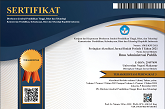Potential policy impacts: Establishment of Indonesian mining state-owned holding company
(1) Univeristas Indonesia
(2) Univeristas Indonesia
(*) Corresponding Author
DOI: https://doi.org/10.26858/jiap.v9i2.11762
Abstract
Government of Republic of Indonesia has been working to establish and operate the State-Owned Holding Company for Mining sector. There has been a long debate in whether in public, government institution, even in the industry on how this policy would give impact to all stakeholders within the business. While this mining state-owned holding company keep going on its mission to achieve the policy’s objectives, in order to monitor the track we are at, this paper is trying to observe on the potential policy impacts and how can we manage to solve any damage, if there is any, so that the negative implications from the policy can be understood better and well handled by the government as well as the holding.
Keywords
Full Text:
PDFReferences
Akpan, M., Wanke, P., Chen, Z., & Antunes, J. M. (2019). Unveiling the Endogenous Relationship Between Technical Efficiency and Value Creation in Mergers and Acquisitions in Nigeria. South African Journal of Economics.
Alexandridis, G., Antypas, N., & Travlos, N. (2017). Value creation from M&As: New evidence. Journal of Corporate Finance, 45, 632–650.
Alford, J. (2002). Defining the client in the public sector: A social‐exchange perspective. Public Administration Review, 62(3), 337–346.
Banerjee, A., & Eckard, E. W. (1998). Are mega-mergers anticompetitive? Evidence from the first great merger wave. The Rand Journal of Economics, 803–827.
Creswell, J. W., & Creswell, J. D. (2017). Research design: Qualitative, quantitative, and mixed methods approaches. Sage publications.
Du, F., Tang, G., & Young, S. M. (2012). Influence activities and favoritism in subjective performance evaluation: Evidence from Chinese state-owned enterprises. The Accounting Review, 87(5), 1555–1588.
Essig, M., & Batran, A. (2005). Public–private partnership—Development of long-term relationships in public procurement in Germany. Journal of Purchasing and Supply Management, 11(5–6), 221–231.
Fountain, J. E. (2001). Paradoxes of public sector customer service. Governance, 14(1), 55–73.
Hermawan, A. A., & Adinda, G. (2012). The effect of board characteristics and audit committee existence on earnings quality of Indonesian state-owned enterprises. Available at SSRN 2135051.
Karnani, A. (2007). The mirage of marketing to the bottom of the pyramid: How the private sector can help alleviate poverty. California Management Review, 49(4), 90–111.
Kim, B. (2018). Is Narcissism Sustainable in CEO Leadership of State-Owned Enterprises? Sustainability, 10(7), 2425.
Menozzi, A., Gutiérrez Urtiaga, M., & Vannoni, D. (2011). Board composition, political connections, and performance in state-owned enterprises. Industrial and Corporate Change, 21(3), 671–698.
Muhammad, H., Rehman, A. U., & Waqas, M. (2016). The relationship between working capital management and profitability: A case study of tobacco industry of Pakistan. The Journal of Asian Finance, Economics and Business (JAFEB), 3(2), 13–20.
Purnamasari, D. (2015). The effect of changes in return on assets, return on equity, and economic value added to the stock price changes and its impact on earnings per share. Research Journal of Finance and Accounting, 6(6), 80–90.
Siahaan, R. (2005). BUMN Indonesia: isu, kebijakan, dan strategi. Elex Media Komputindo.
Warganegara, D. L., Hutagaol, Y. R. I., Saputra, M. A., & Anggraini, Y. (2013). State-Owned Enterprises and Corporate Governance Strength: Evidence from Indonesia. International Journal of Management and Business Research, 3(4), 325–335.
Wei, S.-J., & Wang, T. (1997). The Siamese twins: do state-owned banks favor state-owned enterprises in China? China Economic Review, 8(1), 19–29.
Wicaksono, A. (2009). Corporate governance of state-owned enterprises: investment holding structure of government-linked companies. University of St. Gallen.
Article Metrics
Abstract view : 645 times | PDF view : 85 timesRefbacks
- There are currently no refbacks.
Copyright (c) 2019 Chandra Wijaya, Rina Andriani

This work is licensed under a Creative Commons Attribution 4.0 International License.
Diterbitkan oleh:
Program Studi Ilmu Administrasi Publik
Program Pascasarjana Universitas Negeri Makassar
JIAP Index By:

This work is licensed under a Creative Commons Attribution 4.0 International License.









